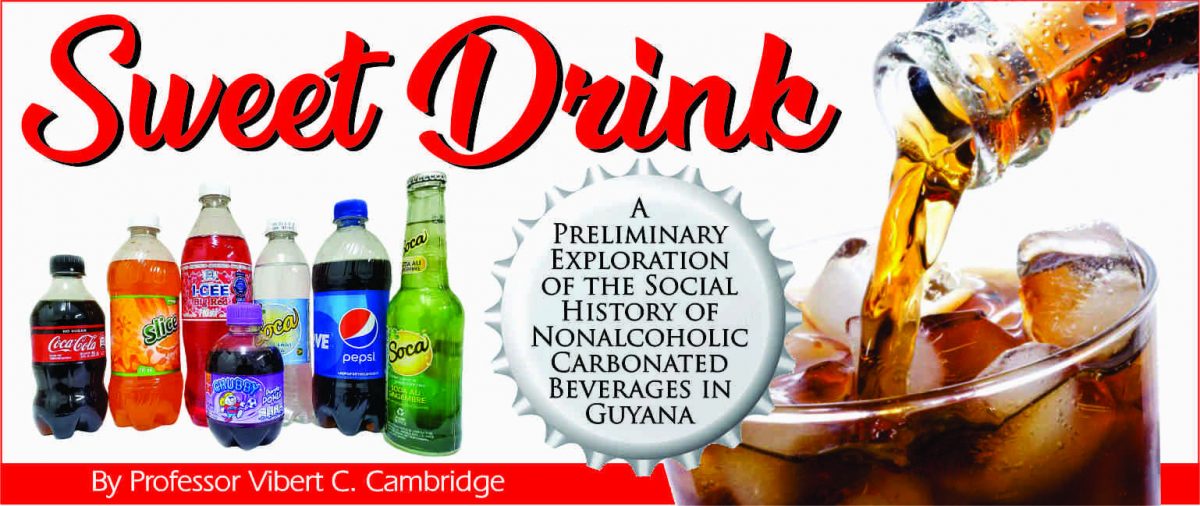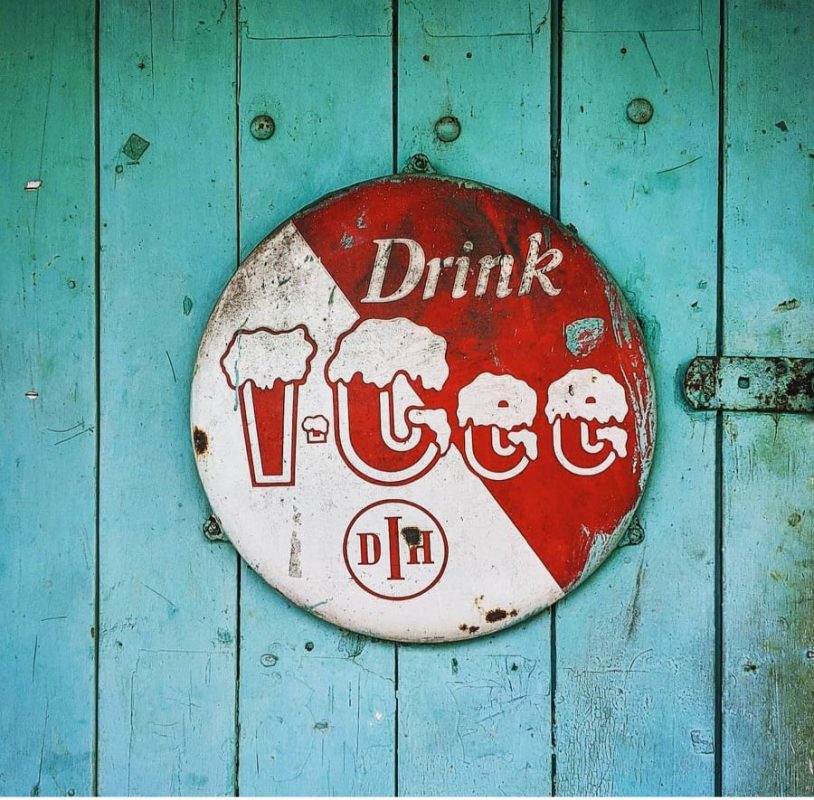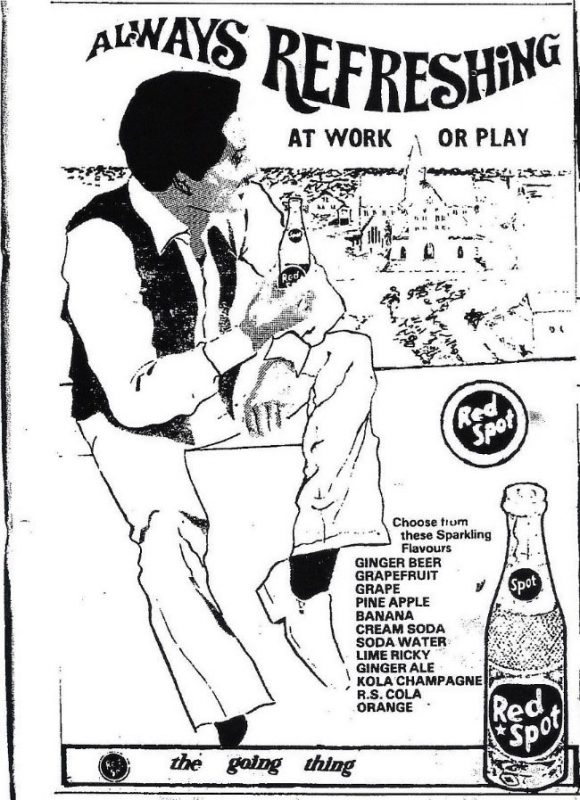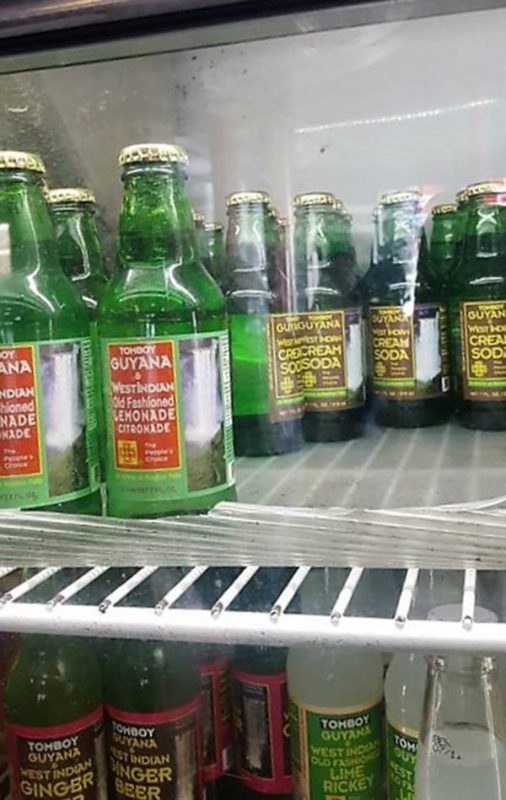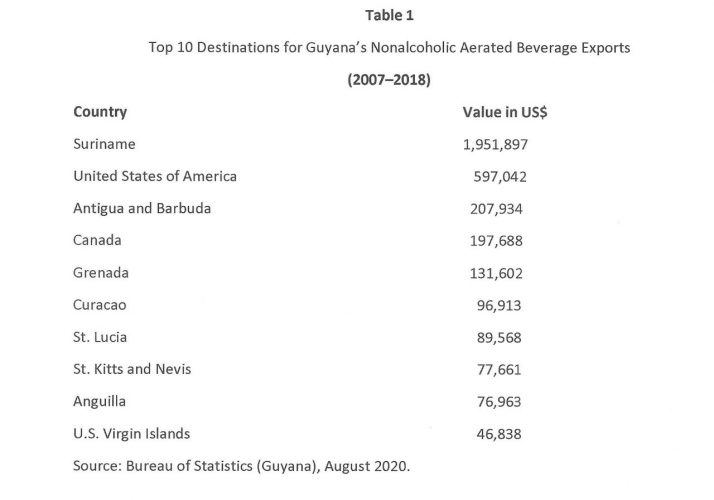When Alfred Mohamed entered the lemonade business in the 1930s, all aspects of the process (bottle washing, syrup boiling, carbonation, filling, crowning [corking or capping], and packing) were manual. The iconic green or brown 6 oz bottles were washed, filled, and crowned by hand-operated machines. The cases, which held 75 small or 48 large lemonade bottles, were moved by hand. However, when the Verdun Aerated Water Factory ceased operations in January 2011, all operations—washing, filling, syrup mixing, labelling, and crowning—were fully automated. The plant was capable of filling 80 bottles per minute.
Bottles have been of special significance in Guyana’s sweet drink industry. The previous installments contained several references to the iconic 6 oz dark small green and brown lemonade bottles, all with glued-on labels. In the 1970s, there was a new development in Guyana’s bottling sector. Several US bottlers switched from glass to plastic (polyethylene terephthalate [PET]) bottles. Some sold their brands and associated glass bottles. During this period, the Verdun Soda Factory started to use TOMBOY “patent bottles” for its lemonade line. Verdun was not the only Guyanese bottler to use retired patent bottles from US soda companies. Bottlers Beverages of 56 D’Urban and Hardina streets was another. Central to bottling is the product flavour.
Formulas and flavours
In an earlier installment, Hamid Mohamed had observed: “The lemonade formula was straightforward—lemon oil extract, white sugar, carbonated water, citric acid, and sodium benzoate.” The core ingredient was white sugar, which was originally imported from the United Kingdom. Bottles of carbonated beverages made with brown sugar were known to explode. Egg whites were added to the white-sugar (simple) syrup to remove residual impurities and ensure a clear final product.
The lemonade formula might have been straightforward, but mixing was complex. There was a formula for the egg white to sugar syrup ratio to ensure a clear product. The lemon oil extract, which provided the flavour, was not soluble in simple syrup. It had to be dissolved in 90% proof neutral alcohol before it could be added to the syrup and the mixture could be carbonated. Mixing required attention to detail. It was the mixing that distinguished small lemonades and maintained customer loyalty.
Flavour diversification
I was unable to determine why John Noel Nichols of Manchester, England, the creator of Vimto, chose British Guiana as the location for his first international venture. Why was BG the first place in which he registered the Vimto trademark in 1919? As was the case with Coca-Cola and Pepsi, this grape-flavored product was originally promoted as a medicine.
It seems that bottlers had been flavouring non-alcoholic carbonated beverages in British Guiana since the early 20th century. Stark’s Guide and History of British Guiana, published during the first decade of the 20th century, presents an advertisement from Virtue & Company, “dispensing, wholesale and retail chemists and druggists,” listing the following as flavours of “aerated waters and beverages” offered: “soda water, West Indian tonic, Crystal Lemonade, Colonial Ginger Ale, Brewed Ginger beer, Etc, Etc”. In 1914, the Royal Crown Soda factory was one of the 10 bottling companies in British Guiana listed in the US Department of Commerce publication, Trade Directory for South America. Given the product line of the Royal Crown brand in the US during the early 1900s, it is possible that strawberry, root beer, and cola flavours were also bottled in British Guiana during this early period.
In 2019, in addition to producing lemonade, Crown Spot Soda Factory Ltd, probably the largest of the few community-based “sweet drink factories in Guyana, was also bottling the following flavors: Banana, Classic Green, Cola Fruit Champ, Grape, Orange, Pineapple, and Tangerine.” In 2020, Crown Spot was one of the few bottlers in Guyana still using recyclable glass bottles.
It was noted that Willems Lemonade Factory, H E Reis, DeAbreu, Russian Bear Bottlers, and Verdun also bottled a range of flavours. This was no doubt a response to the flavour options provided by the emerging giants: DIH, CSID, and Red Spot (bottled by Rahaman’s Soda Factory beginning in the mid-1950s). For example, by the mid-20th century, D’Aguiar Bros Ltd had introduced lime rickey, Vimto, Pepsi, and I-Cee flavours. Wieting and Richter’s Cold Storage and Ice Depot (CSID) had Coca-Cola, 7UP, and the Juicee and Star lines with the popular punch and orange flavors.
By the mid-20th century, Rahaman Soda Factory, the Red Spot bottlers, introduced flavours such as banana, cream soda, ginger beer, ginger ale, grape, grapefruit, orange, Kola Champagne, R S Cola, and lime rickey. According to Red Spot advertising, its flavours were “Always Refreshing” and “The Going Thing.” Prior to bottling the Red Spot line, Rahaman Soda Factory bottled Wonder—a lemonade.
In response to this changing terrain, Verdun Soda Water Factory also bottled several flavours, such as orange, ginger beer, cream soda, lime juice, and the blackberry-flavoured Portello. Portello, a viable alternative to Vimto, was previously bottled by Mr DeAbreu’s factory and sold in a larger-than-usual 20 oz bottle. Size mattered!
So, although the Lemonade People had to respond to the diversity of flavours from the competition, lemonade, in either 6 oz or 10 oz bottles, was always the core business. When Verdun reintroduced the Portello brand, it also reintroduced the 20 oz bottle. Howere, despite the range of available flavours, lemonade has remained popular.
Like the bottling technologies, the essences for these flavors were imported primarily from the United Kingdom, the United States, and, occasionally, Trinidad or Barbados.
Competition and camaraderie
The Verdun Aerated Water Factory was always a leader in the lemonade business in Guyana. It was probably the dominant player in Demerara. By the 1970s, its small lemonade was dominant in the Linden market. Around the same period, Banks DIH decided that it would enter the Linden lemonade market. According to Hamid Mohamed, its lemonade was sold in “fancy DIH bottles”, but apparently, it failed to gain traction. It seems that the Lemonade People knew the importance of the small green or brown bottles for creating a customer base and maintaining brand loyalty.
In November 2019, Crown Spot Soda Factory Ltd reaffirmed the importance of these coloured bottles with its Facebook post announcing its desire to purchase used “beer bottles, Stag bottles, and Carib (short neck) bottles” that were in good condition. This represented recycling and repurposing because imported beer bottles, especially the dark green ones associated with Trinidad’s Stag brand, are not reused by the original bottlers. In Guyana, they are most appropriate for bottling the iconic small lemonade. The materials used for bottling sweet drinks in Guyana are among the problems for which a sustainable solution is needed.
The 1970s brought dramatic changes to Guyana’s political and economic life. The nation adopted a Republican system of government, socialism as its organizing ideology, and nationalization as its dominant economic strategy. By the mid-1970s, there was a dramatic downturn of the economy, a function of various domestic and international factors, including Cold War era geopolitics, and the OPEC oil crisis. This resulted in the introduction of severe foreign exchange controls. Consequently, the sweet drink industry found it difficult to purchase vital materials from international suppliers. According to Hamid Mohammed, the foreign exchange controls “killed the small bottler in Guyana.”
For an industry that was dependent on foreign inputs, these were tough times. However, this fostered camaraderie among the lemonade companies and other players in the industry. There are stories about the Verdun Aerated Water Factory going to the assistance of Banks DIH. There are also stories of Rahaman Soda Factory and Banks DIH loaning each other white sugar to ensure adherence to the specifications of Coca-Cola and Pepsi, their respective franchised brands.
Among the consequences of these political and economic shifts in Guyana during the 1970s was the acceleration of emigration and the expansion of the Guyanese diaspora, especially in the United Kingdom, Canada, and United States. Eventually, some of the Lemonade People developed markets overseas, especially in locations such as London, Toronto, and New York, with significant Guyanese populations.
Diaspora
The Verdun Aerated Water Factory ended operations in Guyana in 2011. However, the Mohamed family has continued to produce the popular small lemonade under the TOMBOY label in New York. During the 1980s, Raymond Mohamed, Ayube Mohamed’s son, migrated to the United States where he started a small video rental business. The rise of the Blockbuster chain adversely affected his business, so he turned to the family business: bottling nonalcoholic, aerated beverages. Using the TOMBOY brand, Raymond Mohamed entered into an agreement with a “contract bottler” and launched a soda business in New York. TOMBOY lemonade, banana, cream soda, ginger beer, Kola Champagne, lime rickey, and pineapple became available in outlets in Brooklyn, Queens, the Bronx, and Miami in 2019.
From 2007 to 2018, Guyana exported more than US$4 million in nonalcoholic aerated beverages to locations with significant Guyanese populations. These included Suriname, the United States, Antigua and Barbuda, Canada, Grenada, Curacao, St Lucia, St Kitts, Anguilla, and the US Virgin Islands. Table 1 lists the destinations and export value of Guyanese nonalcoholic beverages for 2007 to 2018. I am currently unable to identify what percentage of these exports were small lemonades.
Summarizing
Guyana has had a special place in the history of nonalcoholic, carbonated beverages in the Caribbean. During the late 19th century, British Guiana-based Commission Agent Alfred
Russell distributed the early technologies to Trinidad and no doubt, Guyana. In Guyana, the industry’s origins are traced to a group of entrepreneurs, several of whom were immigrants. Some came to the colony of British Guiana to try their luck in the early years after the emancipation of enslaved Africans. There were also homegrown entrepreneurs. Primarily men, they are endearingly known as the Lemonade People. They developed a special sweet drink category, the small lemonade, which endures in Guyana’s taste culture—at home and in the diaspora.
The changing political and economic conditions of the 1970s dealt a mortal blow to the Lemonade People. However, their demise had started even earlier when a few local companies became franchisees for international brands and sought to dominate the local marketplace. The next installment begins the exploration of the “sweet drink wars” that mortally wounded Guyana’s lemonade industry.
SELECTED REFERENCES
Rodway, J and James H. Stark. Stark’s Guide and History of British Guiana, containing a description of everything related to this colony that would be of interest to tourists and residents, respecting its history, inhabitants, climate, agriculture, geology, gold mining, government, and resources. Boston: J. H. Stark. ca. 1900-1907.
Cambridge, V. Facebook conversation, “The Geography of ‘Sweet Drinks’ in Guyana” launched April 21, 2020. https://www.facebook.com/vibert.cambridge/posts/10157045271290849?comment_id=10158058760755849¬if_id=1624887773436591¬if_t=feed_comment&ref=notif
